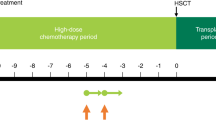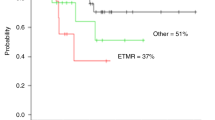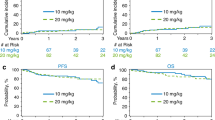Abstract
In an attempt to improve the dismal prognosis of adults with recurrent medulloblastoma, six patients were treated with aggressive salvage therapy including high-dose chemotherapy (HDCT) and autologous stem cell transplantation (ASCT). At relapse, all patients underwent surgical debulking followed by HDCT/ASCT and then radiotherapy when possible. The treatment plan included two cycles of HDCT/ASCT; first with cyclophosphamide, etoposide and carboplatin (CECb) and then 2 months later with cyclophosphamide and thiotepa (CT). Three of the six patients received the planned therapy. One patient experienced severe toxicity requiring life-sustaining therapy. This patient developed multi-organ dysfunction including multiple enhancing lesions in both cerebral hemispheres that slowly resolved over several months. Two other patients did not mobilize sufficient stem cells for two ASCT procedures. They received one ASCT conditioned with cyclophosphamide, thiotepa and carboplatin (CTCb). Three of six patients had a complete response (CR); the other three had a partial response (PR). Following the first ASCT, median duration of response was 13.5 months (range 9–29 months) and median survival was 21.5 months (range 12–42 months). There was no treatment-related mortality. We conclude that HDCT/ASCT with CECb-CT or CTCb is active against recurrent medulloblastoma in adults and may be associated with prolonged remissions. Multiple enhancing cerebral lesions on brain MRI early post-HDCT/ASCT may be a consequence of the treatment rather than metastatic disease.
This is a preview of subscription content, access via your institution
Access options
Subscribe to this journal
Receive 12 print issues and online access
$259.00 per year
only $21.58 per issue
Buy this article
- Purchase on Springer Link
- Instant access to full article PDF
Prices may be subject to local taxes which are calculated during checkout

Similar content being viewed by others
References
Torres CF, Rebsamen S, Silber JH et al. Surveillance scanning of children with medulloblastoma New Engl J Med 1994 330: 892 895
Walker R, Allen J . Cisplatin in the treatment of recurrent childhood primary brain tumors J Clin Oncol 1988 6: 62 66
Khan AB, D'Souza BJ, Wharam MD . Cisplatin therapy in recurrent childhood brain tumors Cancer Treat Rep 1982 66: 2013 2020
Allen J, Walker R, Luks E et al. Carboplatin in recurrent childhood brain tumors J Clin Oncol 1987 5: 459 463
Ashley DM, Meier L, Kerby T et al. Response of recurrent medulloblastoma to low-dose oral etoposide J Clin Oncol 1996 14: 1922 1927
Crafts D, Levin V, Edwards M et al. Chemotherapy of recurrent medulloblastoma with combined procarbazine, CCNU, and vincristine J Neurosurg 1978 49: 589 592
Cangir A, Ragab A, Steuber P et al. Combination chemotherapy with vincristine, procarbazine, prednisone with or without nitrogen mustard (MOPP versus OPP) in children with recurrent brain tumors Med Ped Oncol 1984 12: 1 3
Levin V, Vestnys P, Edwards M et al. Improvement in survival produced by sequential therapies in the treatment of recurrent medulloblastoma Cancer 1983 51: 1364 1370
Brandes AA, Palmisano V, Monfardini S . Medulloblastoma in adults: clinical characteristics and treatment Cancer Treat Rev 1999 25: 3 12
Lundberg JH, Weissman DE, Beatty PA et al. Treatment of recurrent metastatic medulloblastoma with intensive chemotherapy and allogenic bone marrow transplantation J Neurooncol 1992 13: 151 155
Dunkel IJ, Boyett JM, Yates A et al. High-dose carboplatin, thiotepa, and etoposide with autologous stem-cell rescue for patients with recurrent medulloblastoma J Clin Oncol 1998 16: 222 228
Graham ML, Herndon JE II, Casey S et al. High-dose chemotherapy with autologous stem-cell rescue in patients with recurrent and high-risk pediatric brain tumors J Clin Oncol 1997 15: 1814 1823
Finlay JL, Goldman S, Wong MC et al. Pilot study of high-dose thiotepa and etoposide with autologous bone marrow rescue in children and young adults with recurrent CNS tumors J Clin Oncol 1996 14: 2495 2503
Ascensao J, Ahmed T, Feldman E et al. High-dose thiotepa with autologous bone marrow transplantation for patients with astrocytoma grade III–IV (glioma): A promising approach Proc Am Soc Clin Oncol 1989 8: 90
Millot F, Delval O, Giraud C et al. High-dose chemotherapy with hematopoietic stem cell transplantation in adults with bone marrow relapse of medulloblastoma: report of two cases Bone Marrow Transplant 1999 24: 1347 1349
Kessinger A . High-dose chemotherapy with autologous bone marrow rescue for high grade gliomas of the brain: a potential for improvement in therapeutic results Neurosurgery 1984 15: 747 750
Fine HA, Antman KH . High-dose chemotherapy with autologous bone marrow transplantation in the treatment of high grade astrocytomas in adults: therapeutic rationale and clinical experience Bone Marrow Transplant 1992 10: 315 321
Friedman HS, Colvin OM, Skapek SX et al. Experimental chemotherapy of human medulloblastoma cell lines and transplantable xenografts with bifunctional alkylating agents Cancer Res 1988 48: 4189 4195
Friedman HS, Colvin OM, Ludeman SM et al. Experimental chemotherapy of human medulloblastoma with classical alkylators Cancer Res 1986 46: 2827 2833
Heideman RL, Cole DE, Balis F et al. Phase I and pharmacokinetic evaluation of thiotepa in the cerebrospinal fluid and plasma of pediatric patients: evidence for dose-dependent plasma clearance of thiotepa Cancer Res 1989 49: 736 741
Tartaglia RL, Cole DE, Heideman R et al. Chemosensitivity of central nervous system tumors to thiotepa and tepa Proc Am Assoc Cancer Res 1989 30: 461
Heideman RL, Packer RJ, Reaman GH et al. A phase II evaluation of thiotepa in pediatric central nervous system malignancies Cancer 1993 72: 271 275
Screnci D, McKeage MJ . Platinum neurotoxicity: clinical profiles, experimental models and neuroprotective approaches J Inorg Biochem 1999 77: 105 110
Author information
Authors and Affiliations
Rights and permissions
About this article
Cite this article
Zia, M., Forsyth, P., Chaudhry, A. et al. Possible benefits of high-dose chemotherapy and autologous stem cell transplantation for adults with recurrent medulloblastoma. Bone Marrow Transplant 30, 565–569 (2002). https://doi.org/10.1038/sj.bmt.1703725
Received:
Accepted:
Published:
Issue Date:
DOI: https://doi.org/10.1038/sj.bmt.1703725
Keywords
This article is cited by
-
Salvage therapy for progressive, treatment-refractory or recurrent pediatric medulloblastoma: a systematic review protocol
Systematic Reviews (2020)
-
Updates on Management of Adult Medulloblastoma
Current Treatment Options in Oncology (2019)
-
Management of recurrent medulloblastoma in adult patients: a systematic review and recommendations
Journal of Neuro-Oncology (2013)
-
Radiation-induced adult medulloblastoma: a two-case report and review of the literature
Journal of Neuro-Oncology (2011)
-
Extraneural metastatic medulloblastoma in an adult
Journal of Neuro-Oncology (2006)



